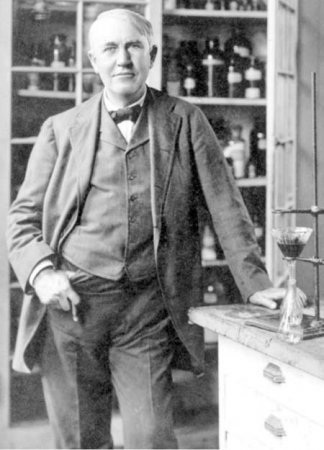Thomas Alva Edison
Identification: American inventor and innovator
Born: February 11, 1847; Milan, Ohio
Died: October 18, 1931; West Orange, New Jersey
Significance: Using his entrepreneurial skills to implement business diversification and divisional structure in the format of mass production, Edison dramatically influenced modern society by developing, manufacturing, and marketing practical products, particularly electric lightbulbs, electric generating systems, phonographs, and motion-picture projectors.
Selling newspapers, candy, and vegetables on the Grand Trunk Railway and later working as a telegraph operator for the same company helped young Thomas Alva Edison recognize his skills as a businessman and motivated him to develop an intense work ethic, resourcefulness, and creativity. In his spare time, he concentrated on reading and experimenting with printing presses, electrical systems, and mechanical apparatuses.
Through his invention and sale of improved telegraphic devices, Edison earned the money necessary to establish an industrial research lab in Menlo Park, New Jersey, in 1876 with the goal of inventing, manufacturing, and marketing useful products. He did not want to be an inventor who just turned ideas into patents; rather, he wanted to reap the financial benefits that would result from also producing and selling practical inventions. After initially manufacturing incandescent lightbulbs in Menlo Park, Edison set up a large factory in Harrison, New Jersey, to pursue that task. He learned that the cost of manufacturing a product could be significantly lowered by implementing mass production technology. Attracting several financial backers, Edison established the Edison Electric Light Company in New York City in 1878. The company was incorporated as the Edison Electric Illuminating Company in 1880.
In 1887, Edison moved his industrial laboratory toWest Orange, New Jersey, where he concentrated on making useful small products, such as his electric fan and phonograph, that had a high profit potential and low capital requirement. Edison was one of a very few American businessmen during the 1890’s who were willing to gamble on new ideas and new markets for consumer goods in rapidly growing American cities. By 1906, Edison had manufactured more than one million phonographs.
Thomas Alva Edison. (Library of Congress)
Another important product produced at the West Orange laboratory was Edison’s motionpicture camera. After he experienced financial disasters in the electrical industry and the ore-milling business, motion pictures reestablished Edison’s fame and fortune as an inventor and a businessman. By 1910, Edison had expanded and diversified his business into a stream of assembly-line products, including film projectors, motion pictures, phonographs, electric fans, storage batteries, and Portland cement. He quickly established new companies and built factories for each new product, and in 1911 he formed Thomas A. Edison, Inc., as the umbrella organization to consolidate his many business ventures. Although Edison failed to keep up with changing consumer expectations during the 1920’s, he was responsible for pioneering the model for the successful development and management of industrial research. His diversified, divisional business structure became the standard of business organization in the twentieth century.
Alvin K. Benson
Further Reading
Alvarado, Rudolph. The Life and Work of Thomas Edison. Indianapolis, Ind.: Alpha, 2002.
Millard, Andre. Edison and the Business of Innovation. Baltimore: Johns Hopkins University Press, 1993.
Pretzer, J.William S. Working at Inventing: Thomas A. Edison and the Menlo Park Experience. Baltimore: Johns Hopkins University Press, 2002.
See also: Bell, Alexander Graham; General Electric; Industrial research; Industrial Revolution, American; Inventions; Motion-picture industry; Music industry; Public utilities.

